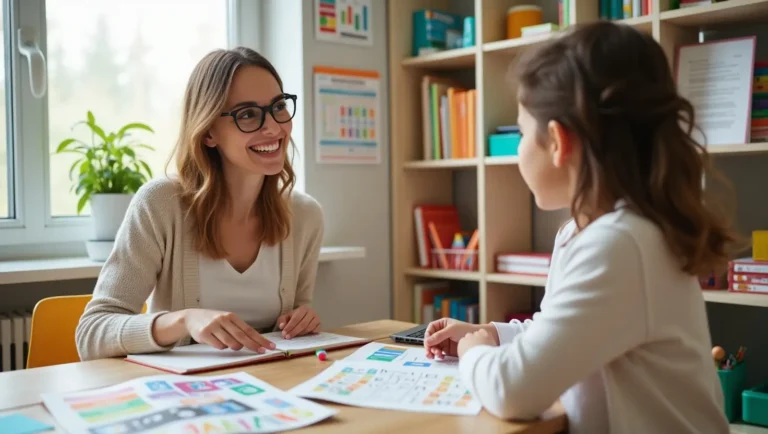The Ultimate Guide to Dyslexia Treatment: Evidence-Based Interventions for Children and Adults
Understanding Dyslexia and the Path to Effective Treatment
Dyslexia affects approximately 10-15% of the population, making it one of the most common learning differences worldwide. Yet despite its prevalence, many misconceptions persist about what dyslexia truly is and how it can be effectively treated. Dyslexia treatment is not a one-size-fits-all approach—it requires understanding, patience, and evidence-based interventions tailored to each individual’s unique needs.
At its core, dyslexia is a neurobiological learning difference that primarily affects reading accuracy, fluency, and spelling. It’s not a reflection of intelligence or effort; many individuals with dyslexia are highly creative, innovative thinkers who simply process language differently. The key to successful outcomes lies in early identification, accurate diagnosis, and implementing appropriate dyslexia treatment for kids and adults alike.
Let’s debunk some common myths right away: Dyslexia cannot be “cured” with vision therapy alone, special colored lenses, or dietary changes. While these approaches may help some individuals with specific visual or attention challenges, the core reading difficulties of dyslexia require structured, systematic language instruction based on decades of scientific research.
Understanding Diagnosis: The Foundation of Effective Treatment
Before exploring treatment options, it’s crucial to understand that effective dyslexia treatment begins with proper diagnosis. A comprehensive dyslexia assessment should only be conducted by qualified professionals, including:
- Neuropsychologists
- Educational psychologists
- School psychologists with specialized training
- Speech-language pathologists
- Licensed learning disability specialists
Components of a Comprehensive Assessment
A thorough diagnostic evaluation typically includes:
| Assessment Area | What It Measures | Why It Matters |
|---|---|---|
| Phonological Awareness | Ability to hear and manipulate sounds in words | Core deficit in dyslexia |
| Decoding Skills | Reading unfamiliar words accurately | Fundamental reading skill |
| Reading Fluency | Speed and accuracy of reading | Impacts comprehension |
| Reading Comprehension | Understanding written text | Ultimate goal of reading |
| Spelling/Encoding | Writing sounds into letters | Related to decoding |
| Rapid Naming | Quick retrieval of familiar symbols | Predictor of reading fluency |
| Working Memory | Holding information while processing | Affects learning efficiency |
Differentiating from Other Learning Difficulties
It’s essential to distinguish dyslexia from other conditions that may impact reading, such as:
- ADHD (attention difficulties may mask or coexist with dyslexia)
- Language processing disorders
- Visual processing issues
- Hearing impairments
- Intellectual disabilities
Evidence-Based Interventions & Therapies: The Core of Dyslexia Treatment
The foundation of effective dyslexia treatment for kids and adults rests on scientifically validated interventions. Let’s explore the most proven approaches:
Multisensory Structured Language Education (MSLE)
MSLE represents the gold standard approach to dyslexia intervention. This method engages multiple senses simultaneously—visual, auditory, and kinesthetic-tactile—to strengthen memory and learning pathways.
Core Principles of MSLE:
- Systematic and cumulative instruction
- Explicit teaching of language structure
- Diagnostic and prescriptive approach
- Multisensory engagement
Orton-Gillingham Approach
Target Age Group: Kindergarten through adult Duration: Typically 2-3 years of intensive instruction
The Orton-Gillingham approach is a structured, sequential, multisensory method that teaches the connection between letters and sounds. Research published in the Journal of Learning Disabilities demonstrates significant improvements in reading accuracy and fluency following Orton-Gillingham instruction.
Pros:
- Highly individualized
- Strong research base
- Flexible pacing
- Multisensory engagement
Cons:
- Requires specialized training
- Can be expensive
- Time-intensive
Finding Qualified Practitioners: Look for certified Orton-Gillingham instructors through the Academy of Orton-Gillingham Practitioners and Educators.
Wilson Reading System
Target Age Group: Elementary through adult Duration: 12-24 months on average
The Wilson Reading System is a structured literacy program based on Orton-Gillingham principles. A study in Reading and Writing journal showed significant gains in both word reading and spelling for students using Wilson instruction.
Core Methods:
- 12-step lesson plan structure
- Sound tapping technique
- Systematic phonics instruction
- Fluency development
Lindamood-Bell Programs
Target Age Groups: Preschool through adult
Lindamood-Bell offers several specialized programs:
- Lindamood Phoneme Sequencing (LiPS): Develops phonemic awareness
- Seeing Stars: Improves symbol imagery for spelling and sight words
- Visualizing and Verbalizing: Enhances reading comprehension
Research Evidence: Studies published in Annals of Dyslexia demonstrate improvements in phonological processing and reading comprehension following Lindamood-Bell instruction.
Structured Word Inquiry (SWI)
Target Age Group: Elementary through adult
SWI focuses on understanding how words are built through morphology (meaningful word parts) and etymology (word origins). This approach is particularly beneficial for older students and adults.
Key Benefits:
- Builds vocabulary systematically
- Improves spelling through understanding
- Enhances reading comprehension
- Develops scientific thinking about language
Role of Educational Settings in Dyslexia Treatment
IEPs and 504 Plans: Your Rights and Options
Students with dyslexia are entitled to educational support under federal law. Understanding the difference between these plans is crucial:
Individualized Education Program (IEP):
- Requires eligibility under IDEA
- Provides specialized instruction
- Includes measurable goals
- Offers related services
504 Plan:
- Provides accommodations and modifications
- Based on Section 504 of Rehabilitation Act
- Focuses on equal access
- More flexible than IEP
Essential Accommodations for Students with Dyslexia
| Category | Accommodation Examples |
|---|---|
| Time and Scheduling | Extended time on tests, breaks during long tasks |
| Presentation | Audio versions of texts, enlarged print, highlighted materials |
| Response | Oral responses instead of written, use of speech-to-text |
| Setting | Quiet testing environment, small group instruction |
School-Based vs. Private Intervention
School-Based Interventions:
- Often use Response to Intervention (RTI) model
- May include specialized reading programs
- Provided at no cost to families
- Must align with curriculum standards
Private Therapy:
- More individualized approach
- Specialized methodologies (Orton-Gillingham, Wilson, etc.)
- Flexible scheduling
- Often more intensive
Technological Aids & Assistive Technology
Modern technology offers powerful tools to support individuals with dyslexia:
Text-to-Speech (TTS) Solutions
Popular Options:
- Natural Reader: Web-based and mobile app
- Voice Dream Reader: iOS app with natural-sounding voices
- Read&Write: Comprehensive literacy support software
Benefits:
- Reduces reading fatigue
- Improves comprehension through auditory processing
- Allows access to grade-level content
Speech-to-Text (STT) Tools
Recommended Software:
- Dragon NaturallySpeaking: Professional-grade dictation
- Google Voice Typing: Free web-based option
- Apple Dictation: Built into Mac and iOS devices
Educational Apps and Software
| App/Software | Age Group | Key Features | Research Support |
|---|---|---|---|
| Ghotit | All ages | Spelling and grammar checker for dyslexia | User studies show improvement |
| ModMath | K-12 | Digital graph paper for math | Reduces writing burden |
| Co:Writer | Elementary-Adult | Word prediction software | Peer-reviewed studies available |
Audiobooks and Digital Libraries
Services like Audible, Learning Ally, and Bookshare provide access to thousands of titles in audio format, allowing individuals with dyslexia to enjoy literature and learn content without the barrier of decoding text.
Home-Based Support & Strategies
Creating a Dyslexia-Friendly Environment
Physical Environment:
- Quiet, well-lit study space
- Minimal distractions
- Organized materials and supplies
- Comfortable seating
Emotional Environment:
- Celebrate effort over perfection
- Focus on strengths and interests
- Maintain realistic expectations
- Provide consistent encouragement
Reading Aloud Strategies
Reading to and with your child is one of the most powerful dyslexia treatment strategies you can implement at home:
Effective Techniques:
- Echo Reading: Adult reads first, child repeats
- Choral Reading: Read together simultaneously
- Paired Reading: Take turns reading paragraphs
- Whisper Reading: Child reads quietly while adult follows along
Homework Support Without Enabling
Do:
- Break assignments into smaller chunks
- Provide organizational tools
- Teach study strategies
- Advocate with teachers when needed
Don’t:
- Complete assignments for your child
- Lower expectations unnecessarily
- Focus solely on deficits
- Compare to siblings or peers
Building Self-Esteem and Resilience
Children and adults with dyslexia often face challenges that can impact self-confidence. Building resilience is a crucial component of comprehensive dyslexia treatment for kids and adults:
Strategies for Building Confidence:
- Highlight strengths and talents
- Share stories of successful people with dyslexia
- Teach self-advocacy skills
- Celebrate progress, not just achievements
- Connect with dyslexia support groups
Addressing Co-occurring Conditions
Research indicates that dyslexia frequently occurs alongside other conditions:
ADHD and Dyslexia
Approximately 25-40% of individuals with dyslexia also have ADHD. This combination requires careful treatment planning:
Treatment Considerations:
- Address attention issues first if severe
- Use highly structured, engaging instruction
- Incorporate movement and breaks
- Consider medication consultation if appropriate
Dysgraphia (Writing Difficulties)
Many individuals with dyslexia also struggle with writing:
Support Strategies:
- Teach keyboarding skills early
- Use assistive technology for writing
- Break writing tasks into steps
- Focus on content over mechanics initially
Anxiety and Depression
Learning struggles can lead to emotional challenges:
Warning Signs:
- School avoidance
- Perfectionism
- Social withdrawal
- Physical complaints (headaches, stomachaches)
Support Approaches:
- Counseling or therapy
- Stress management techniques
- Building coping strategies
- Family support and understanding
Treatment Across the Lifespan
Early Intervention (Preschool-Kindergarten)
Focus Areas:
- Phonological awareness activities
- Letter-sound knowledge
- Vocabulary development
- Print awareness
Evidence-Based Programs:
- PAST (Phonological Awareness Skills Test)
- Heggerty Phonemic Awareness
- Fundations (Wilson’s prevention program)
Elementary School (Grades 1-5)
This is the critical window for intensive dyslexia treatment for kids:
Key Components:
- Systematic phonics instruction
- Fluency development
- Vocabulary building
- Comprehension strategies
Recommended Approaches:
- Orton-Gillingham based programs
- Wilson Reading System
- Structured literacy curricula
Middle and High School
Adaptations for Older Students:
- Focus on morphology and etymology
- Develop compensation strategies
- Build self-advocacy skills
- Prepare for post-secondary transitions
Adults with Dyslexia
Dyslexia treatment for adults focuses on:
- Workplace accommodations
- Continued skill development
- Technology training
- Self-advocacy in professional settings
Workplace Rights: Under the Americans with Disabilities Act (ADA), adults with dyslexia are entitled to reasonable accommodations such as:
- Extended time for written tasks
- Audio versions of materials
- Assistive technology
- Modified training methods
Alternative/Unproven Treatments: Proceed with Caution
While exploring treatment options, it’s important to distinguish between evidence-based interventions and approaches lacking scientific support:
Treatments with Limited or No Scientific Evidence
Vision Therapy for Dyslexia:
- May help with visual processing issues
- Does not address core phonological deficits of dyslexia
- Not recommended as primary dyslexia treatment
Dietary Interventions:
- Omega-3 supplements show mixed research results
- Elimination diets lack strong evidence
- Should not replace proven interventions
Auditory Processing Programs:
- May benefit some individuals with specific auditory issues
- Limited evidence for core dyslexia symptoms
- Often expensive without clear benefits
Red Flags in Treatment Claims
Be wary of programs that promise:
- “Quick fixes” or “cures”
- Success without effort or practice
- One-size-fits-all solutions
- Dramatic improvements in weeks
Finding Help & Resources
Questions to Ask Potential Therapists/Tutors
When seeking professional help, ask these important questions:
- What are your qualifications and certifications?
- What specific approach do you use?
- How do you measure progress?
- What is your experience with dyslexia?
- How do you involve families in the process?
- What does your typical session include?
- How long do you expect treatment to take?
Reputable Organizations and Resources
Professional Organizations:
- International Dyslexia Association (IDA)
- Learning Disabilities Association of America
- Understood.org
Research and Information:
Support and Advocacy:
- Decoding Dyslexia
- Local dyslexia support groups
- School district special education departments
Frequently Asked Questions
Q: How early can dyslexia be identified? A: Warning signs can appear as early as preschool, but formal diagnosis typically occurs in elementary school when reading instruction begins.
Q: Is dyslexia treatment covered by insurance? A: Coverage varies by plan. Educational therapy may be covered under some mental health benefits. Check with your insurance provider.
Q: How long does dyslexia treatment take? A: Most individuals need 2-3 years of intensive, specialized instruction. However, support strategies and accommodations may be needed lifelong.
Q: Can adults learn to read if they have dyslexia? A: Absolutely! While it may take longer, adults can significantly improve their reading skills with appropriate instruction.
Q: Are there any famous people with dyslexia? A: Yes! Many successful individuals have dyslexia, including Richard Branson, Temple Grandin, Anderson Cooper, and Whoopi Goldberg.
Conclusion: Your Journey Forward
Effective dyslexia treatment is not about finding a magic cure—it’s about understanding how your brain works differently and using that knowledge to build skills, confidence, and success. Whether you’re seeking dyslexia treatment for kids or exploring options as an adult, remember that dyslexia is a difference, not a disability.
The journey may require patience, persistence, and professional support, but with evidence-based interventions and a strong support system, individuals with dyslexia can achieve their goals and thrive in all areas of life.
Remember to celebrate the unique strengths that often accompany dyslexia: creativity, problem-solving abilities, big-picture thinking, and resilience. These qualities, combined with appropriate support and instruction, create a foundation for lifelong success.
Glossary of Terms
Decoding: The ability to translate written words into spoken words by using knowledge of letter-sound relationships.
Fluency: The ability to read text accurately, quickly, and with proper expression.
Morphology: The study of word structure and how words are formed from smaller meaningful units.
Multisensory Instruction: Teaching methods that engage visual, auditory, and kinesthetic-tactile learning pathways simultaneously.
Phonological Awareness: The ability to recognize and manipulate the sound structure of language.
Structured Literacy: An approach to teaching reading that is systematic, explicit, cumulative, and multisensory.







